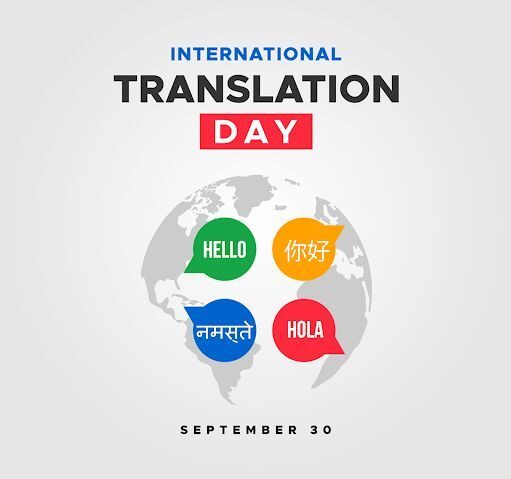🌐 Introduction: The Bridge That Connects the World
Imagine a world without translations. Global literature would stay locked in its native tongue. Legal documents couldn’t cross borders. Diplomacy would collapse, and millions would be excluded from knowledge. That’s the void translators fill every day — quietly, diligently, and masterfully.
- 🌐 Introduction: The Bridge That Connects the World
- 🗓️ Timeline: The Journey of International Translation Day
- 📚 The Origin: Why September 30?
- 🧠 9 Undeniable Reasons Why Translation Day Deserves Global Respect
- 🧾 Important Facts About International Translation Day
- ❓ FAQs About International Translation Day
- ✨ The Significance of Translation in Daily Life
- 🌎 How We Observe Translation Day
- 💬 Wishing Messages on International Translation Day
- 🏆 Why International Translation Day Is Important to Society
- 🌟 Impact on Our Daily Lives
- 🧩 Key Takeaways – Important Points Recap
- 🧭 Conclusion: More Than Just Words
International Translation Day, observed every September 30, is a tribute to these unsung heroes of global communication. This day acknowledges their invaluable work in fostering cross-cultural understanding, preserving knowledge, and maintaining peace.
Let’s explore why this day matters deeply, not just to translators but to all of us.
🗓️ Timeline: The Journey of International Translation Day
| Year | Milestone |
|---|---|
| 3rd Century AD | Death of St. Jerome, patron saint of translators, who translated the Bible into Latin. |
| 1953 | International Federation of Translators (FIT) was established. |
| 1991 | FIT proposes September 30 as International Translation Day. |
| 2017 | The United Nations officially recognizes September 30 as a global observance. |
| Today | Over 100+ countries observe the day through events, seminars, and tributes to language professionals. |
📚 The Origin: Why September 30?
International Translation Day falls on September 30 to commemorate the death of St. Jerome, the most famous translator in Christian history. His Latin translation of the Bible, the Vulgate, remains foundational to Christian theology and liturgy.
St. Jerome’s dedication to linguistic clarity and cultural context set the gold standard for translators. Today’s observance honors his legacy and the broader mission of translators across industries.
🧠 9 Undeniable Reasons Why Translation Day Deserves Global Respect
It honors invisible heroes: Translators and interpreters work behind the scenes but are essential to every sector — diplomacy, literature, law, healthcare, education, and more.
It bridges cultural divides: Translation allows us to read Tolstoy, Tagore, or Murakami — expanding our worldview and empathy.
It preserves languages and heritage: Translators document endangered languages and indigenous oral traditions before they vanish.
It ensures international justice: In courts and legal systems, fair trials across borders require accurate interpretation.
It supports global peacekeeping: From the UN to NATO, interpreters mediate dialogues in crises and conflict zones.
It drives global business: Localization teams help brands connect with audiences in their native tongues, boosting commerce.
It spreads health and safety: Translators ensure life-saving COVID guidelines, medicine instructions, and emergency alerts reach all communities.
It nurtures multilingual education: Students worldwide benefit from translated academic papers and research.
It champions inclusion and human rights: Translating refugee testimonies, gender rights charters, or disability support resources makes equality real.
🧾 Important Facts About International Translation Day
🌍 Over 7,000 languages exist globally, yet 90% of digital content is available in just a handful.
📖 UN documents are translated into 6 official languages: English, French, Arabic, Chinese, Russian, and Spanish.
🧏♀️ Sign language interpreters are also recognized on this day, emphasizing language beyond words.
🔄 The machine translation market is booming, yet human translators are still irreplaceable for context, emotion, and nuance.
🗣️ Simultaneous interpreters often listen, understand, translate, and speak — all at once!
❓ FAQs About International Translation Day
Q1: Is International Translation Day a public holiday?
No, it’s a global observance, not a public holiday. Workplaces, schools, and organizations operate as usual.
Q2: Who started International Translation Day?
The International Federation of Translators (FIT) initiated it in 1991. The UN formally adopted it in 2017.
Q3: Why is translation important today more than ever?
Globalization, migration, and digital transformation have created a multilingual world, requiring clarity across languages in every domain.
Q4: What’s the difference between translation and interpretation?
Translation: Written content (e.g., books, documents).
Interpretation: Spoken communication (e.g., meetings, courtrooms, conferences).
Q5: How can one celebrate this day?
Attend translation-themed webinars, read world literature in translation, thank a language professional, or promote multilingual awareness online.
✨ The Significance of Translation in Daily Life
Without realizing it, we benefit from translation every single day:
That Netflix series from Spain or Korea? Translated.
That online course from a European university? Translated.
That user manual for your smartphone? Translated.
From memes to medical prescriptions, translation is the silent engine of accessibility and understanding.
It makes the global local. It turns distant ideas into shared experiences. It’s the linguistic electricity that powers our world.
🌎 How We Observe Translation Day
Here’s how International Translation Day is observed across the world:
🔹 Language Fairs & Exhibitions: Organizations host language events, especially in universities and embassies.
🔹 Award Ceremonies: Recognitions like the Translation Prize highlight exceptional contributions.
🔹 Social Media Tributes: Hashtags like #TranslationDay, #LanguageMatters, and #ThankATranslator trend globally.
🔹 Panel Discussions & Webinars: These promote best practices and ethical discussions in the profession.
🔹 Community Projects: Some NGOs translate content for marginalized groups, such as migrant workers or disabled communities.
💬 Wishing Messages on International Translation Day
You can wish translators and interpreters in respectful, uplifting ways:
“To those who make the world speak one language of understanding – Happy Translation Day!”
“Your work may be silent, but its impact echoes globally.”
“Thanks to translators, the world is not lost in translation.”
“Every word you bridge brings people closer. Happy International Translation Day!”
🏆 Why International Translation Day Is Important to Society
Translation plays a social, educational, economic, and emotional role in our lives:
Promotes social justice and reduces inequality.
Fosters global citizenship through multilingual learning.
Keeps cultures alive and evolving.
Encourages peaceful diplomacy in times of crisis.
Powers economic development by connecting global markets.
Without translation, knowledge would be trapped. Ideas would be isolated. And people would feel excluded.
🌟 Impact on Our Daily Lives
Even if you don’t work in linguistics, translators impact your life:
Travel: Airport signs, tourist guides, and hotel forms are multilingual.
Healthcare: Instructions for medicine or consent forms are often translated.
Technology: Most app interfaces and websites are localized.
Consumer Goods: From shampoo bottles to electronics, everything comes in multiple languages.
Translators don’t just translate words — they translate intent, tone, and meaning.
🧩 Key Takeaways – Important Points Recap
International Translation Day is celebrated September 30 in honor of St. Jerome.
Recognized globally by the UN and FIT.
Celebrates translators, interpreters, linguists, and their role in uniting humanity.
Emphasizes importance in diplomacy, literature, education, justice, commerce, and healthcare.
A day of gratitude, learning, and advocacy for multilingual inclusivity.
🧭 Conclusion: More Than Just Words
As we navigate a rapidly globalizing world, translation is more than a profession—it is a promise:
A promise that no voice will be unheard, no story untold, and no culture left behind.
International Translation Day is a beautiful reminder that in diversity, we find strength—and through language, we find unity.
So let’s thank a translator, read something translated, and celebrate the bridge builders of our world.








